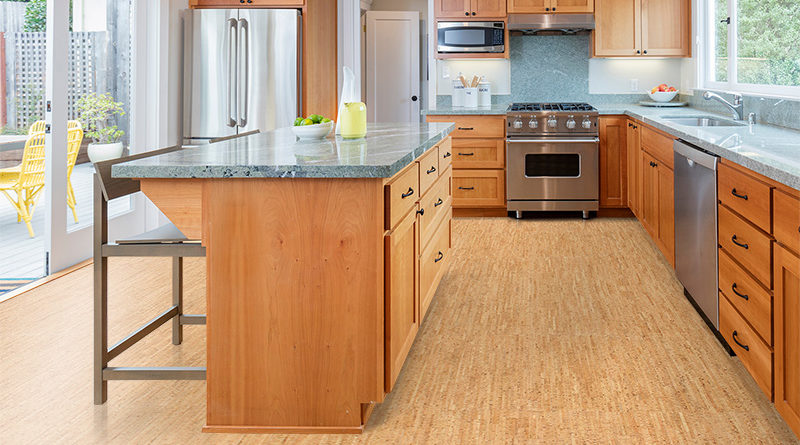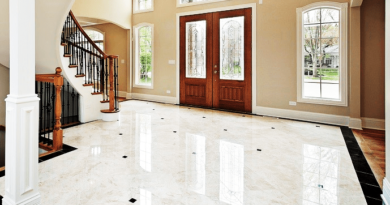CORK FLOORING | An Architect Explains
Cork commonly used as wine bottle stoppers is also a natural flooring material and a green, or environmentally friendly product. It comes from the bark of the cork oak tree, native to the Mediterranean which has a lifespan of 250 years. Cork flooring has been in use for many decades in libraries and churches because it absorbs foot falls and noise. But now you see it everywhere.

The bark is hand-harvested every nine years, leaving a protective inner layer of bark that allows the tree to continue to grow and regenerate new bark. After drying, the cork bark is punched up for wine bottle stoppers and the remaining cork is boiled, ground up, and compressed using no- or low-VOC (volatile organic compounds) adhesive resins to form cork sheets which can be cut and used as flooring.
Cork has both advantages and disadvantages. It is useful to know the characteristics of Cork, its usability and suitability as a flooring option. As an Architect, I have described Cork along with it’s features under the following headings so that you can decide whether it is suited for your requirement and your space:
What are the advantages of Cork flooring?
What are the disadvantages of Cork flooring?
Where is Cork flooring best suited?
WHAT ARE THE ADVANTAGES OF CORK FLOORING?
Cork is available as either tiles or interlocking planks and has a host of advantages:
- Sustainable flooring option: Since Cork is renewable, it has been heralded as a green, eco-friendly flooring option. Hence, there is a marked increase in interest shown in this product in recent times.
- Recycled content: Instead of ending up in a landfill, the waste from the production of corks is transformed into cork flooring.
- Sleek look: Cork goes well with contemporary homes.
- Cushioning effect: A wine-bottle cork can be squeezed, but it will bounce back to the original shape. This unique property gives cork flooring a cushioning effect under foot.
- Insulates: The air cells within the cork help to trap heat acting like an insulator for the floors.
- Sound proof: Cork flooring is also sound-resistant and has a degree of fire-resistance.
- Anti-allergen: Due to a naturally occurring wax called Suberin within cork, the product is insect-resistant and anti-allergen.
- Stain and water resistant: Cork resists mildew and is water-proof. It is also stain resistant.
- Fire resistant: Cork is fire-resistant and does not release any toxic gases on combustion.
- Durable: Cork is as durable as wood, but an extra application of sealer is recommended in damp rooms.
- Variety: Cork flooring comes in a wide variety of styles, colours and shapes offering a range of design possibilities.

WHAT ARE THE DISADVANTAGES OF CORK FLOORING?
While, Cork does have many benefits, you should know its limitations before making a decision for your home.
- Not suited everywhere: Cork does not go well with all decors. Therefore it is less popular than wood.
- Refinishing: Polyurethane finishes typically last up to seven years before refinishing is required, UV-cured acrylic finishes are not as long-lasting and Wax finishes need reapplication every 6-12 months.
- Not indestructible: Cork will scratch and show indentations, specifically from high-heeled shoes and pet toenails. For this reason, it’s recommended to outfit furniture feet with soft pads or coasters.
- Fades with time: Unlike hardwood floor, cork gets lighter with exposure to light. Windows with UV-protective coatings or window coverings can prevent fading to some extent.
- Affected by humidity: This can cause Cork to swell or warp with changes in moisture.
- Cost: Finally, cork flooring is more expensive than some varieties of carpeting and vinyl tiles.

WHERE IS CORK FLOORING BEST SUITED?
Cork being a renewable product is very popular among environment-friendly homeowners. It goes well with modern homes, is sound-proof and cushion-y. Therefore it is popularly used in Basement. Because of it’s water proof qualities, it is also used in Bathrooms. But it can get dented and is not as cost-friendly as Vinyl or carpet. So it is not a common flooring choice.
For information on other flooring options, go to:
- Flooring | Natural Material Options
- Flooring | Man-made Material Options
- Flooring | Resilient Material Options
READ MORE:
In order to get a rough idea of the suitability of a particular flooring for your requirement and to make a fair comparison of the different types of flooring, refer to an Architect’s rating of the various kinds of flooring on my blog: House construction in India
If you found this post useful, all it takes is a simple click on the “pin it” “like,” “share,” “tweet,” or Google+ buttons below the post.




